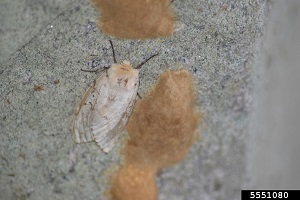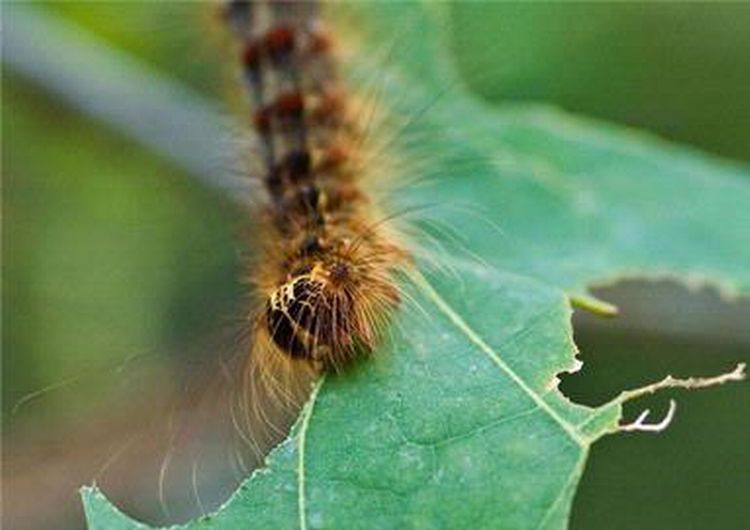NORTHERN MICHIGAN – Gypsy moth caterpillars have been busy this spring in areas across Michigan. As these now large caterpillars near the pupal or cocoon stage, tree defoliation is at its peak.
In highly infested areas, the caterpillars’ munching is audible, and round pellets of frass, or waste, rain down throughout the day and night. Oaks, aspens, willows and other host trees may be nearly leafless, or defoliated, by their feeding.
The hairy, yellow-faced caterpillars with pairs of red and blue spots down their backs can be found on buildings, vehicles, equipment or anything that’s been outside for a while.Widespread invasive gypsy moth outbreaks in Michigan became apparent in the mid-1980s. Suppression programs in the 1990s and 2000s introduced predators, parasitoids and a fungal disease called Entomophaga maimaiga to aid the naturally occurring nucleopolyhedrosis virus (NPV) in controlling populations.NPV and the fungal disease have important benefits – they are specific to gypsy moth populations and do not affect people, pets or beneficial insects like pollinators or insect predators. In addition, they remain in the environment, continuing to help control gypsy moth populations every year. The fungal disease spreads best in moist springs, so this year’s drought conditions may have slowed its activity. |
These suppression efforts have continued to keep gypsy moth populations largely in check since the 1990s, naturalizing gypsy moth infestations into Michigan’s forests. Today, gypsy moth outbreaks are cyclical, peaking approximately every seven to 10 years. In these years, the virus and the fungal disease are spread more easily through dense populations, eventually causing a crash.
What to do right now
| After six to eight weeks of feeding, caterpillars build cocoons. This inactive stage should be beginning now in the southern Lower Peninsula and in one to two weeks in the northern Lower Peninsula, providing a natural end to the nuisance.If trees have been defoliated in your yard, water them frequently to help them “re-flush” and produce a second set of leaf buds for the year. Healthy forests will re-flush on their own with little to no long term impacts.Remember, some decline is natural. Removing old or stressed trees from the ecosystem is critical to allow for more vigorous regeneration to take their place. While caterpillars prefer leaves, if forced to, they will eat needles on pines, spruces and other conifers. These trees cannot re-flush, so remove caterpillars when possible to prevent tree loss. |
The window for effective pesticide application has passed, but if caterpillars remain a nuisance on your property, there are a few inexpensive but effective things you can do to protect individual trees.
- Make a tree trunk trap: Cut a band of burlap 18 inches wide and long enough to go around the tree trunk and overlap a bit. Tie a string around the center of the band to make a two-layered skirt around the trunk. When caterpillars climb trees daily to feed, they will get caught in the band. Scrape them into a bucket of soapy water to kill them.
- Use a safe and easy spray: Soap and water mixed in a garden sprayer can be applied to caterpillars climbing on trunks, decks or siding.
- Gear up: It’s best to wear gloves when coming into contact with caterpillars, as their hairs can cause a slight allergic reaction in some people.
What’s next?
 Approximately two weeks after cocooning, adult gypsy moths will emerge for a short mating cycle. Females are white with brown to black markings and do not fly. Males are gray to brown with dark markings and will fly to locate females. Females produce a single, fuzzy, tan to brown egg mass that can hold over 200 eggs.Egg masses will persist until next spring when the hatch begins. To lessen impacts next year, it is important to look for, remove and destroy egg masses. |
- Look on trees, buildings, outdoor furniture and playsets – anything that’s outside.
- Use a scraper or hard plastic card to scrape egg masses into a container of soapy water.
- Let them soak overnight, then bag and dispose of them.
- Alternately, egg masses can be placed in a fire and burned.
- Note that just scraping them onto the ground will not kill the eggs, and egg masses will still hatch next spring.
- It’s important to check for and remove egg masses from cars, equipment and anything that has been outdoors before you pack up for your travels.
- Leave firewood at home – it’s a common source for spreading gypsy moth.


